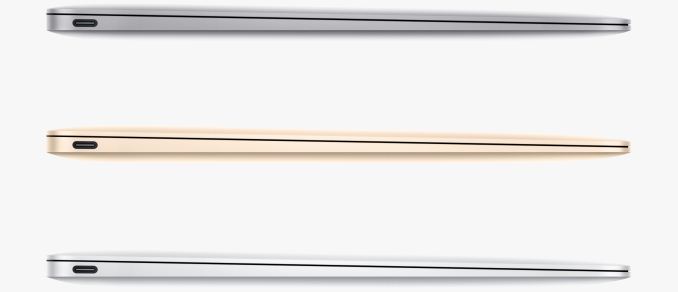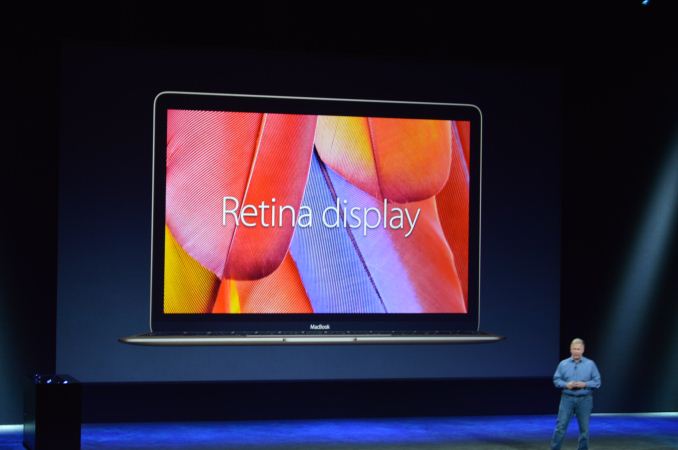Apple Announces The New MacBook (2015)
by Brandon Chester on March 9, 2015 4:30 PM EST
Today Apple announced a brand new MacBook laptop. This new laptop doesn't fall under Apple's existing MacBook Pro and MacBook Air categories, but is instead simply called the MacBook. In truth, this is actually more like the return of an old name that hasn't been seen in some time, rather than the creation of a new product line. When the MacBook Air was introduced, consumers overwhelmingly chose it over the original MacBook line. It eventually absorbed that category of Apple's laptops, while the Pro line remained for users who needed something with more processing power.
| The New MacBook | |
| Dimensions | 28.05 x 19.65 x 0.35–1.31cm |
| Mass | 920g |
| CPU | Intel Core M-5Y70 or M-5Y71 |
| L3 Cache | 4MB |
| Base CPU Clock | 1.1GHz or 1.2GHz |
| Max CPU Turbo | 2.9GHz |
| GPU | Intel HD Graphics 5300 |
| System Memory | 8GB 1600MHz LPDDR3 |
| Storage | 256GB or 512GB PCI-E SSD |
| Display | 12" 2304x1440 IPS LCD |
| Battery | 39.7Wh |
| Ports | 1 x USB Type-C, 3.5mm combo jack |
| Connectivity | 2x2 802.11a/b/g/n/ac + BT 4.0 |
| Price | $1299 or $1599 |
This new MacBook was recently rumored, and there have been many different reactions from Apple fans and tech press alike. It's certainly a departure from even the existing MacBook Air, and in many ways it seems more fitting of the Air name than the current Air does. Apple's goal was clearly to make something thin, light, and almost appliance like. They've certainly succeeded, but in order to get there the MacBook makes some big changes to what is currently thought of as a notebook.
The biggest change is to physical connectivity. Macs currently come with a couple of USB ports, a couple of Thunderbolt 2 ports, a 3.5mm jack for audio, and some connector for power. The new MacBook goes in a completely different direction, ditching every single legacy port with the exception of the 3.5mm jack. Instead, the MacBook has a single USB Type-C port on the left side, and this port is the only method of connecting with other devices, as well as charging. It's a huge departure from the current MacBooks and laptops in general, and only time will tell how well consumers respond to this change.
Apple's pursuit of thinness also necessitated changes to the input devices when compared to other MacBooks. With a slimmer chassis comes less space for the key switches underneath the key caps. In order to make the keyboard on the new MacBook, Apple designed a new type of key switch which they are calling a Butterfly Switch. This new switch is 40% thinner than the scissor switches used on older MacBooks, and it eliminates the wobble that occurs when pressing on the edges of scissor switches. The trackpad has also been redesigned to use Apple's Force Touch technology from the Apple Watch. which allows the user to press anywhere on the trackpad to click, and gives a haptic response to presses. It can also determine the force of a press to perform gestures or other actions. Both of these changes are interesting, but they do make large changes to the feel of the keyboard and trackpad. Key travel distance has certainly been reduced, and the new trackpad won't have the clickiness of the old ones. It will be interesting to see how consumers react to these changes.
Apple's other goal seems to have been making the new MacBook fanless. In order to do so, the new MacBook utilizes Intel's new Core M processors. The starting configuration at $1299 uses Core M-5Y70 which has a base frequency of 1.1GHz and a turbo frequency of 2.9GHz. The 1.2GHz Core M-5Y71 is available in the $1599 model, and a 1.3GHz version is available as a build to order option on Apple's online store. All models come with 8GB of LPDDR3 memory standard.
Like all of Apple's recent products, the new MacBook comes with a Retina display. This is a 12" 2304x1440 IPS display, which equates to 226 pixels per inch. While this new MacBook is not a MacBook Air, it's good to see the thin and light laptop in Apple's line finally moving both to a high resolution display as well as to an IPS panel. Assuming that Apple does the same 2x scaling that they've used in all of their other products, users will be given a desktop with the same area as a 1152x720 display which is actually slightly lower than the 11" MacBook Air. Apple specifies that the scaled resolutions available are 1440x900, 1280x800, and 1024x600, although it remains to be seen how well Intel's HD 5300 will keep up when rendering at 2880x1800 offscreen for the 1440x900 scaled mode.
This new MacBook reminds me a lot of the iPad. It has a port for charging and for interfacing with other devices via adapters, and a port for your headphones. Everything else is meant to be done wirelessly, and there's certainly no room for user upgrades or repairs. It's very much an appliance-like computer, and it's something very different from any laptop Apple has ever done before. I naturally want to feel skeptical about it, but the MacBook Air was an equally dramatic shift from the norm when it was first introduced, and it eventually replaced the original MacBook line entirely. Whether or not the changes in the new MacBook become common among future laptops is up to consumers. If you want to be one of the first people to enter uncharted territory with this new MacBook, it'll be available in just over a month, on April 10.












119 Comments
View All Comments
Novacius - Monday, March 9, 2015 - link
The Asus UX305 ist available since january, is not thicker than 12mm, weights just 1.2kg at 13.3 inch (3200x1800 IPS) and also has Core M as well as an aluminium unibody. It costs 999€ with 8GB/256GB. The new MacBook seems just like a smaller and lighter version of that notebook. It's still impressive, but nothing new in general. But still, everyone gets a boner, cuz it's Apple.kyuu - Monday, March 9, 2015 - link
The new Dell XPS 13 is also superior to this in just about every conceivable way. It has a smaller footprint for a larger screen. Smaller footprint is notable. Simply being thinner (and throwing out every port so it has less connectivity options than a lot of tablets) doesn't really have much advantage in this form factor. Still, you know people will buy it just because Apple.mczak - Monday, March 9, 2015 - link
I'd definitely prefer a XPS 13 over this (the "no ports" is a compromise I wouldn't be willing to accept) the footprint of the XPS 13 is however still larger, in both dimensions that matter (by 2 and 1 cm, respectively), though indeed the screen size / chassis ratio is better with the XPS 13.And obviously performance wise the XPS 13 is in a whole different class, under full load it will easily be twice as fast though for web surfing the difference will be minimal (turbo clock is somewhat similar). Of course, the XPS is also quite a bit more heavy, making it more of a MBA 13 competitor (except that this has a crappy screen with larger bezels and hence larger chassis size).
Honestly I don't quite get the MacBook and MBA split. Choose between reasonably fast cpu or good display. Granted fanless super thin may sound nice but I don't really have any need for a tablet with a built-in keyboard.
kyuu - Tuesday, March 10, 2015 - link
Yeah sorry, obviously the XPS is actually a little larger but you're getting an inch more screen, much better performance, and roughly equal battery life out of it. Size to screen ratio, like you said.It's also rather baffling why they didn't refresh the Air with a "retina" display. The only thing I can think of is that they're planning to phase out the Air soon. Or perhaps it's going to be their "budget" laptop range and sticking in a higher-res display would have raised the cost too much.
Laxaa - Tuesday, March 10, 2015 - link
I agree. The Air is already thin and portable enough and a retnina display would be a welcome upgrade for sure.Calista - Monday, March 9, 2015 - link
"I naturally want to feel skeptical about it, but the MacBook Air was an equally dramatic shift from the norm when it was first introduced, and it eventually replaced the original MacBook line entirely."Well, Apple also added another USB-port and later on Thunderbolt as compared to the first generation. So clearly they had to make some concessions as well.
Thermogenic - Monday, March 9, 2015 - link
Seems incredibly reminiscent of the Lenovo Yoga 3 Pro, doesn't it? Sans touch screen and that cool hinge, of course.digiguy - Monday, March 9, 2015 - link
Core M is just the Broadwell equivalent of the Haswell Y line. Its bad reputation is due to the first pc that used it, the yoga 3 pro, that had a very low TDP and is not necessarily representative of Core M. Core M can have a higher TDP. I don't think fanless is necessarily better. My Surface pro 3 I3, that has the Y processor and a TDP of 11W is virtually fanless. There are only 2 things that make the fin kick in: synthetic benchmarks that take the CPU load to 100% and games that stress the GPU, otherwise it's impossible to have the fan on. But I am happy when the fun turns on while gaming, as my Surface never throttles, contrary to the i5 and i7 and also contrary to Core M. Still Core M with higher TDP and a fan can be an excellent solution, and according to benchmarks it's already between Haswell I3 and I5 (e.g. Lenovo Helix), which is more than enough for a lot of uses (provided there is enough RAM). And do not compare to Bay trail, Bay Trail is still far behind my I3, let alone Core M.zodiacfml - Tuesday, March 10, 2015 - link
Whatever but this is brilliant. The average Joe wouldn't need the ports in a traditional notebook. External display could be done on the USB type C port. A USB hub might be sold separately. Better if it has a memory card reader for photography users.WiFi AC will be sufficient for almost all networking and data a user needs.
Even I don't use more than one USB port of notebooks these days.
Impulses - Tuesday, March 10, 2015 - link
Hells to the yes, I couldn't care less about the MacBook but it's fantastic to see them bet everything on Type C, this should push the adoption rate pretty aggressively.